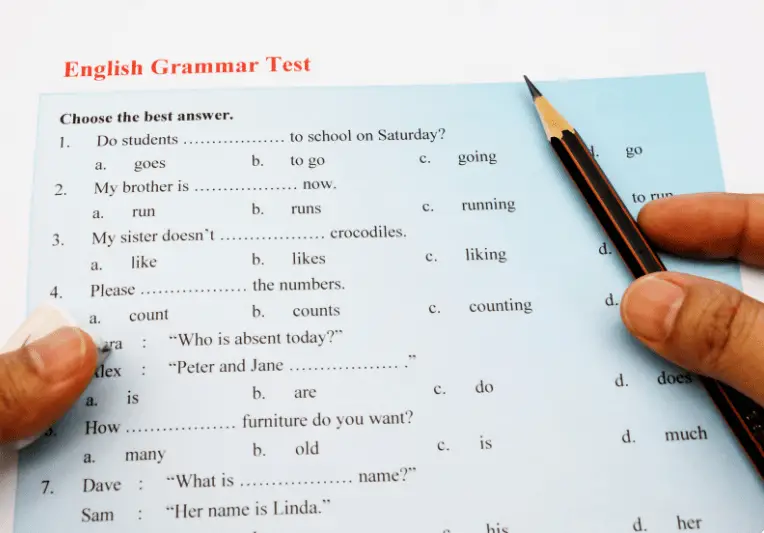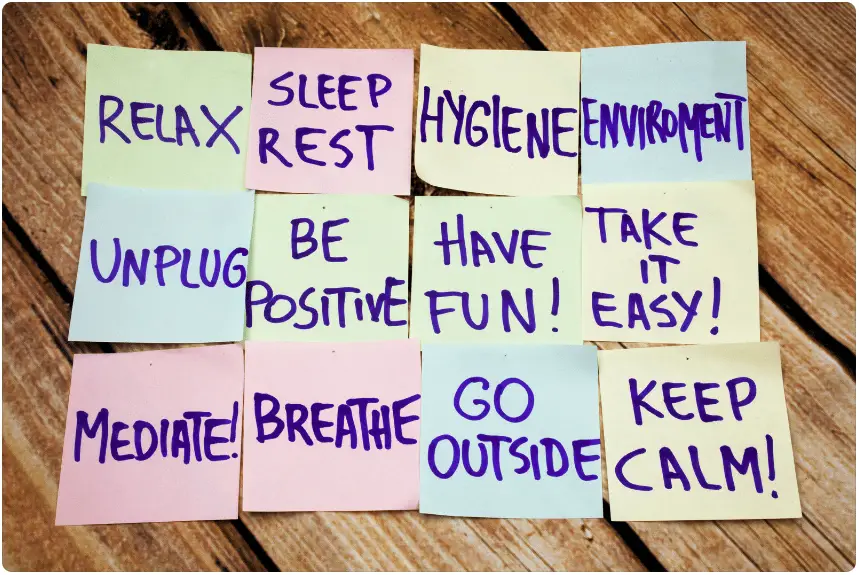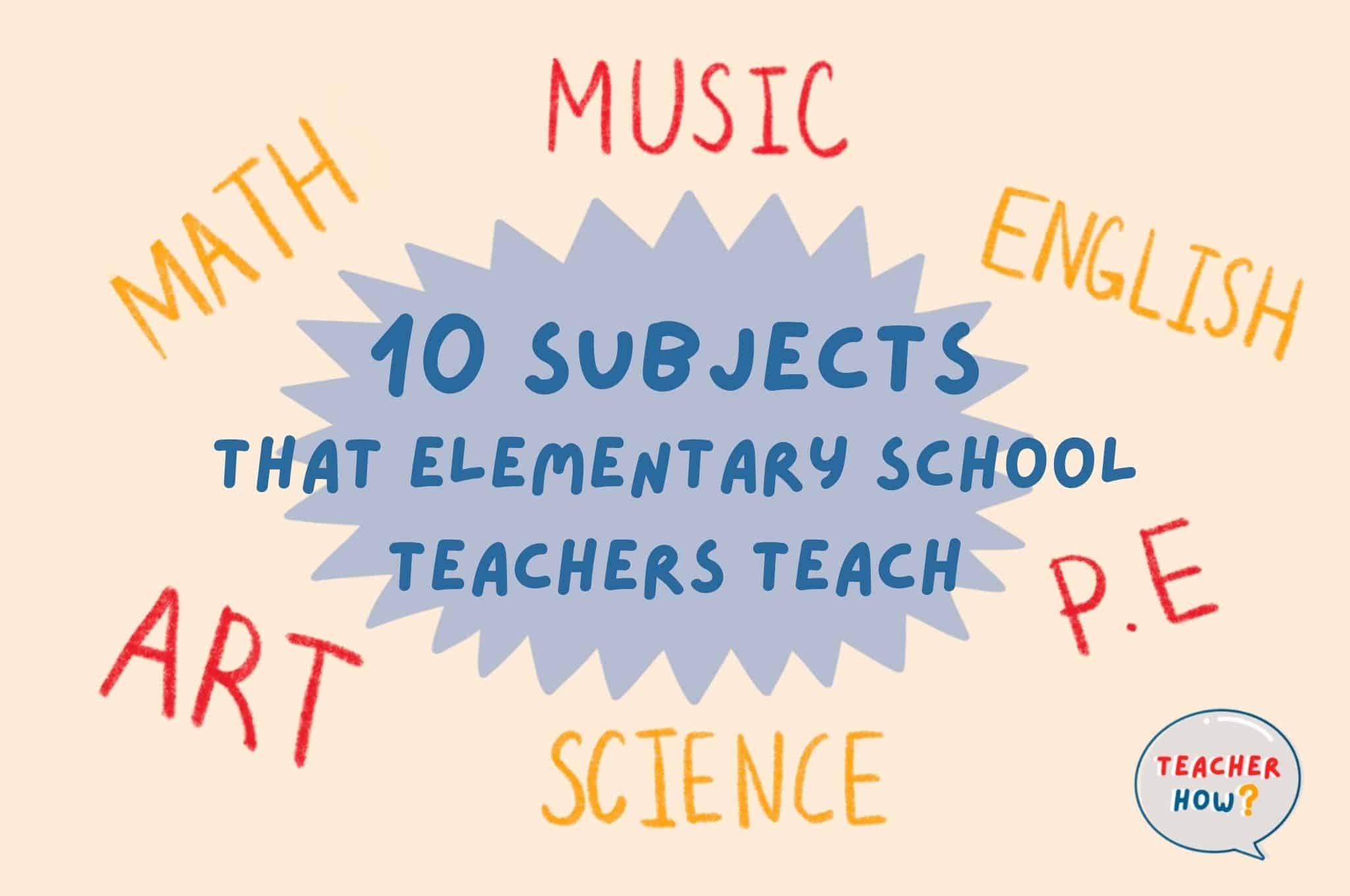Elementary school teachers don’t just teach one subject. Some schools require elementary teachers to teach all subjects, meaning that these educators must have a well-rounded knowledge of every academic discipline and plan accordingly for each subject.
Here are 10 subjects that elementary school teachers teach:
- Mathematics
- English Language
- Social Studies
- Science
- Physical Education
- Health
- Foreign languages
- Art
- Music
- Computer Science / Information Technology
Let’s jump into an elementary school teacher’s shoes and explore how they are able to cover such an extensive list of subjects.
1. Mathematics
Mathematics is one of the foundational subjects for everyday life. It focuses on developing a child’s ability to think, count, measure, compare and solve things.
According to Mississippi College, math and science learning in early childhood often correlates with school readiness and academic achievement in the long term.
Elementary school mathematics usually covers various scopes of the subject. The teachers teach the basics of number theory, including:
- Representing numbers
- Ordering and comparing numbers
- Addition
- Subtraction
- Division
- Multiplication
- Fractions
- Decimals
- Percentages
- Converting standard and non-standard units
- Measuring distance, mass, and volume
- Measuring and reading time

The Math curriculums in most countries often divide the various strands of mathematics into different sections. However, the educational system in the United States teaches mathematics in elementary and middle school as an integrated subject until students advance to divisions like Algebra I and II, Geometry, Calculus, and others in high school.
The way teachers introduce and teach math is changing rapidly in many US states due to the Common Core Math Standards system. The primary principle of the Common Core Standard is to make understanding the reason for and process of a solution just as crucial as the answer itself.
Unlike traditional Math teaching, the standard now encourages students to understand procedures, apply the concepts as they know them, and give input about how they think. To achieve this, teachers teach concepts in a more organized manner and target the students’ learning toward solving real-life problems.
This development means closer monitoring of the students and careful grading. In addition, that means that every lesson plan must change to adopt the new standards, which is why some teachers might be slightly resistant to the shift.
To learn more about elementary school math, including how it is implemented and the challenges teachers face, check out the article, “How hard is it to teach math in elementary school?”
2. English Language
English is also considered a core subject, and the elementary phase of teaching English is focused on learning and developing comprehension and communication skills. Teachers divide this subject into four major branches:
Reading
The principal aim of reading classes is to teach comprehension. The students learn to identify letters and sounds, understand words, and use simple sentences. As they move on to learning through short texts, they determine how to find the main idea of written work, make simple inferences, and draw conclusions from it. Over time, the students reach a level of proficiency that allows them to read independently and discover knowledge themselves.
The National Assessment of Educational Progress is a standardized test taken by students in Grade 4 to test their proficiency in reading and comprehension. This digital assessment uses grade-appropriate literary texts to evaluate reading knowledge, and elementary school teachers are responsible for preparing their students to take the test.
Spelling
Spelling proficiency influences many vital skills, and overlooking those skills may be one of the reasons many adults still struggle with correct spelling. The advent of spell-checkers may have made spelling much easier, but they’re not always accurate and cannot replace rudimentary spelling skills.
Research has shown that spelling, reading, and writing are closely linked skills as they all rely on the relationship between letters and sounds. According to Catherine Snow, an educational psychologist and applied linguist, “knowing the spelling of a word makes the representation of it sturdy and accessible for fluent reading.”
Literacy expert Timothy Shahanan believes that efficient spellers are more willing to use a vast vocabulary and can devote their cognitive resources to formulating and communicating their ideas rather than worrying about constructing words.
At school, teachers would often focus on one particular sound or spelling rule each week and assign a list of words that contain this sound for their students to practice learning. For instance, if the spelling rule was ‘-tion’, students would be expected to study how to spell words like action, station, question, etc.
Grammar
Grammar essentially refers to the rules governing the use of a language, so it is an essential part of teaching efficient written and spoken communication.
Understanding grammar helps young students communicate their basic and complex thoughts through correct and meaningful words, phrases or sentences while speaking or writing.

Writing
Writing is another essential skill taught in elementary school under the umbrella of the English Language subject.
It equips the students with skills for written communication and confident self-expression because learning to write effectively helps them explain and refine their thoughts and ideas. Writing tasks also gives them an avenue to put the skills they have learned in other areas like grammar and spelling to practical use.
Most elementary school teachers facilitate and teach writing through personal prompts. A typical example of a writing prompt is “Write about an important experience in your life” or “Write about something that happened over the weekend.”
Furthermore, teachers often alternate the writing genre focus throughout the year to teach and expose students to various writing styles. This will include exploring the features of narrative writing, informational text, poems, recounts, etc.
Regardless of the method used, the students are taught the different writing strategies, how to pick their ideas, and organize their thoughts into the correct format. They also learn to write with purpose and communicate effectively to various audiences.
3. Social Studies
Social Studies is a subject intended to teach about the study of the functioning of human society and its social relationships.
In elementary school, Social Studies lays an essential foundation for the social sciences and humanities like geography, history, political science, and sociology.
The National Council for the Social Studies (NCSS) is the largest professional association of Social Studies educators in the US. The association’s standards for Social Studies are the most widely accepted, and they divide the subject into ten themes:
- Culture
- Time, Continuity, and Change
- People, Places, and Environments
- Individual Development and Identity
- Individuals, Groups, and Institutions
- Power, Authority, and Governance
- Production, Distribution, and Consumption
- Science, Technology, and Society
- Global Connections
- Civic Ideals and Practices
According to the NCSS, Social Studies must be an essential part of the curriculum throughout the elementary years if young learners are to become effective participants in a democratic society.
Exploring past and present civilizations and the impact of their norms on our culture and institutions helps students to participate actively, respectfully, and intelligently in a globalized world.
Understanding the variety and complexity of human experiences also helps students address intricate issues through cooperative problem-solving.
Elementary school teachers may teach Social Studies by first introducing the sociological concept of needs. The students understand the importance of fundamental needs like food, shelter, and clothing and how they can meet these needs.
Students are also taught the names and significance of historical events, along with why we celebrate popular national and cultural holidays.
Over time, the students use maps and atlases to learn basic geography. They also learn about culture, economics, and the basic structure of government.

As you can see, Social Studies covers an extensive list of topics that a teacher should be knowledgeable and confident about to best educate their students.
Furthermore, teachers are recommended to integrate social studies outcomes with the other subjects as much as possible. For example, students learning about U.S. Presidents can be tasked with writing a letter to a former President they read about. This way, they study history while practicing reading and writing skills.
4. Science
Science is another integral part of education that involves studying the structure and behavior of the physical world.
Elementary school science stimulates students’ curiosity and encourages them to inquire about the world around them through learning, observation, and experiments.
Science is a broad subject, and at the elementary level, students only study life sciences, earth and space sciences, and physical sciences.
As for topics, the curriculum varies across all US states, but the Next Generation Science Standards (NGSS) have the most significant influence on how science is taught in schools.
The NGSS includes core areas in natural science, engineering, and technology branches. While learning the content of biological sciences, the students are also taught the methods of scientific and engineering practices by investigating, creating models and hypotheses, analyzing data, and designing solutions to problems.
To lay the foundation for this standard of learning, elementary school teachers may teach science with different curriculums, but always in increasing levels of complexity. For example, in Clayton School District, Missouri, elementary school students start science by learning about air, weather, and the atmosphere under Earth Science.
They learn to use weather instruments, observe daily weather, and construct parachutes and kites. The students also learn about rock and soil formation, weathering, pollution, and Earth’s minerals.
Under Space science, they study the sun, moon, planets, the solar system’s organization, and explanations for day and night.
Life science starts with learning about insects and plants. The students look at classifying living organisms and then the life cycle of plants and animals.

As they advance through the grades, they observe the Earth’s biosphere, genetics, food chains, and the internal systems of living organisms.
Physical science also starts with learning about matter and its properties. The students conduct experiments on safe substances like toothpaste and vinegar, construct simple engineering models, and learn the fundamental physics of motion, electricity, and magnetism.
The older elementary students begin to learn the chemistry of atoms, elements, mixtures, change of state, and energy transformation.
Science is another subject that encompasses several topics and learning outcomes.
5. Physical Education
Elementary school physical education is a program for developing psychomotor skills, helping students learn how to stay fit, and giving them the knowledge and skills to engage confidently in physical activity.

The program should be taught by a certified physical education instructor, and the lessons should promote sportsmanship, goal setting, and body management skills.
Through PE, students fundamentally learn the importance of regular exercise and a healthy diet. As they get older, they explore the risks of obesity and how to maintain a healthy body image.
This knowledge encourages students to become informed patients who can discern correct information, ask their healthcare providers the right questions, and make better choices for their physical well-being.
6. Health
The Health program is a component of physical education in some schools, but the two courses have distinct goals. While both programs promote health and wellness, health education seeks to give functional health knowledge to prevent high-risk social behavior in all areas, including mental and emotional health, violence prevention, and sexual health.
It is also an intervention to assist children who may already be at risk of unsafe behavior through individuals, community, relationships, and family.
The National Health Education Standards (NHES) is the general set of guidelines for grade-appropriate requirements in health education in the US.
The students learn about their bodies, hygiene, self-care skills, and safety guidelines at home and school. Older elementary students learn about communicable and non-communicable diseases, anger management, drugs, addiction, harmful substances, and the fundamentals of sex education.

Both the health program and physical education at elementary school can instill lifelong habits on how to lead a well and balanced life – again, emphasizing the importance of the educator’s role.
7. Foreign Languages
US schools’ foreign language programs usually offer French or Spanish at different proficiency levels as second languages.

Research has shown that learning a second language increases self-esteem, creativity, cognitive skills, and competence. It also improves academic performance and helps students become well-rounded global citizens who embrace diversity through different communication channels.
Though only a quarter of elementary schools offers foreign language programs, according to the Center for Applied Linguistics, learning a foreign language is more beneficial at a younger age. It enhances attention control, problem-solving, and switching between tasks. Spanish, the second most common language after English, is more prevalent in US schools than French.
8. Art
In elementary school, “art” is commonly used as a generic term for visual arts.
Art education helps young students build aesthetic awareness of the world around them as they mature. It serves as a medium for them to gain skills, form concepts, and express their thoughts. Art makes students increasingly knowledgeable about history and culture.
In elementary school, the students are first taught basic concepts like drawing lines and creating shapes. They learn about light, dark, primary, and secondary colors, identifying textures, and using simple concepts like repetition. They begin to examine and respond to works of art, understand the subject, and express themselves through art.

Most of all, art promotes creativity! By studying art, a child’s imagination is greatly enhanced, allowing them to come up with more original and exceptional ideas.
Those students who may not be academically confident often find great pleasure and relief in art lessons. It can be the only subject where some pupils feel motivated and free to express themselves. As teachers, we must fuel a child’s passion for art, which can be achieved with engaging and unrestricted lessons.
9. Music
Like visual art, music falls under the creative subjects umbrella. The two disciplines share many similarities, both in the delivery and output.
Music programs are not available in all schools nationwide, unfortunately, but they are immensely beneficial, especially at elementary school levels.
When it is taught, students start by learning the basics like rhythm, pitch, and tempo through simple songs. Eventually, they advance to reading musical notes and being able to play melodies on instruments.

Music education increases a host of skills. Research points to how comprehending musical language can boost a child’s overall cognitive skills.
Teaching music can also relieve stress and anxiety, especially in vulnerable children, who may see music as an escape from distressing experiences.
Finally, music in elementary school often takes place in a group setting, where children must work together harmoniously. As a result, the students develop teamwork and social skills while having fun.
10. Computer Science / Information Technology
Technology plays a significant role in our lives, especially as adults. Therefore, it is worth teaching elementary students the foundational skills they will need when typing, researching, presenting, and communicating using a computer.
Building on the basics, students also learn about the dangers of excessive computer use and how to use digital access positively, stay safe while using the internet, protect their personal information, and avoid cyberbullying.
How effectively and frequently computer science is taught depends on the school’s available resources. Some schools are fortunate to have a device for every student, and large sums of money are invested in bringing the latest educational apps into the classroom.
I am incredibly passionate about utilizing technology effectively in schools to enhance learning. For valuable tips and advice on computer science, read the article, “How to encourage students to use technology responsibly in class.”
Conclusion
Elementary school teachers are jacks-of-all-trades and play a critical role in helping young children understand how the world works around them.
School districts and national associations mandate standards for school instruction in their jurisdictions, so the curriculums discussed here may vary between schools and counties. Still, they all have a common goal – laying a solid knowledge foundation for young students.
This YouTube reiterates the information outlined in this article, but with some additional examples:
Sources
- Common Core State Standards Initiative: Mathematics Standards
- Classroom: Goals for Elementary Math Education Programs
- The Good Schools Guide: The American curriculum (although a better name would be ’50 states 50 curricula’)
- US Department of Education International Affairs Office: Structure of the U.S. Education System: Curriculum and Content Standards
- Victoria State Government: Grammar in early childhood
- Reading Rockets: Should We Teach Spelling?
- De Gruyter: What Teachers Need to Know About Language
- National Council for Social Studies: Powerful, Purposeful Pedagogy in Elementary School Social Studies
- McLouth School District: Elementary PE – Goals & Grade-Level Objectives
- Mississippi College: The benefits of Math and Science for Elementary Students.
- Prodigy: 8 Popular Common Core Math Standards Explained with Examples in the Classroom

